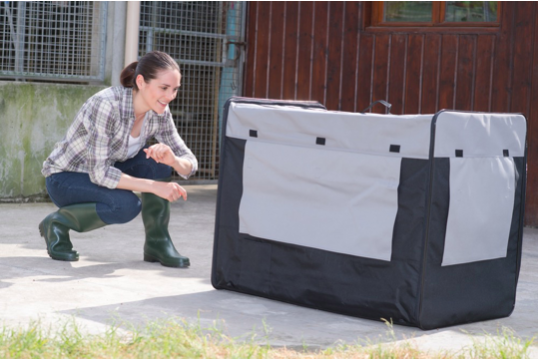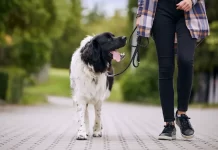If you’re a dog owner, you must have heard about the benefits of crate training. The whole idea is to associate feelings of happiness with the crate, and use the dog’s natural instincts to keep that area clean and comfortable, as well making your dog used to a confined space.
Now, if you’re someone who wants to try crate training your dog but you’re feeling clueless on how to go about the process, then look no further! This article will tell you all about how to crate train your dog or puppy correctly, and what factors to keep in mind.
Table of Contents
Setting up the Crate
Crate training helps your dog to be housetrained and disciplined. It can make life a lot easier for your dog and yourself. But first, you have to set it up properly.
Size and Location
The crate for your dog has to be the right size, allowing adequate room for all sorts of movement. However, the crate can’t be so big that your dog gets the chance to have separate spaces for sleeping and going to the bathroom inside the crate.
As for its location, the crate should be placed in a stable setting which could a place of activity or where it is quiet enough for the dog to rest. It would also be wise to place the crate in an easily cleanable area, in case of accidents.
Crate Type
There are a lot of different crate types and all their features should be examined thoroughly before buying one. For example, kennel crates are ideal for traveling. They are covered on all sides but have ventilation holes and a wire door. Wire mesh crates, the least expensive, are made of chewing resistant wires that give the dogs a view, but lack in the comfort zone.
Puppy pens, on the other hand, are suitable for young dogs and only have wire walls and no cover. These pens need to be used under supervision.
Comfort
Just like us, humans, dogs crave comfort and silence when sleeping too! Some crates like wire mesh crates need to be covered from all sides. However, you should also make sure your dog does not chew on the cover. Putting a plywood on top that extends by 1 foot on the sides and then putting on a cover is a good solution for this. Comfortable washable and soft cloth should be placed on hard crate floors.
Dogs also find comfort in their favorite toys so make sure to keep those around, but be careful about whether they are hazardous.
Training Dos and Dont’s
First of all, never lock your dog into the crate forcefully, or even use it as a form of punishment. Remember, a crate should be a happy place for the dog, not something to fear! Also, initially, try to keep your dog in the room that the crate is located and encourage him to explore the crate on his own.
Upon the first introduction, leave the crate door open and even better, keep a blanket that smells like his mother or littermates, along with treats and toys. It is also important to praise your dog whenever he goes towards the crate, making him associate positive feelings with it.
As for puppies, their training should start early. Puppies need more frequent bathroom breaks so after every 20 minutes, take them outside. Keeping a puppy journal for its bathroom schedule would also be very helpful to maintain a routine.
Night Time
During the night, put your dog in the crate only when he is tired and give him a treat as a distraction, before shutting the door. If you have a puppy, you could place it in a cardboard box next to your bed at night, while crate training properly during the day.
Puppies need a lot of bathroom breaks and you can only leave your puppy in the crate for a maximum of 4 hours. Set alarms for the bathroom breaks accordingly and after using the bathroom, put him back in the crate.
Feeding
Feed your dog its regular meals inside the crate, while leaving the door open. Only start closing the door once the dog is happy eating his meals there, with the bowl all the way inside. As soon as he has finished eating, open the door.
The goal after this is to make sure your dog is okay with having the door closed for about 10 minutes after eating. This should be done gradually, increasing the time in small amounts over big enough intervals for your dog to adjust to this.
Also, if your dog cries, no matter how badly it breaks your heart don’t let him out until he is calm, or else he will assume that crying will open the door.
Extending Crate Time
As the dog gets used to the crate, use commands such as “Crate” along with a hand gesture to direct it to the crate. At meal times, place the bowl in the crate first, and then use the command.
Also use the command randomly and if the dog goes to the crate then, make sure to give it a treat. Sitting with your dog for a few minutes with the door closed also helps him get used to it.
Going Out of Sight
As your dog gets adjusted to the crate, don’t stay with him the entire time he is in the crate. Start leaving the room for a few minutes and return to let him out. Then, gradually increase the amount of time you stay out of sight. If your dog is whining it just means that you’re creating a change too fast, so in that case, cut back the time again.
Slowly keeping increasing the time until your dog is comfortable being in the crate for 30 minutes. At this point, you can leave the house for short periods of times. Except for nighttime, never leave your dog in a crate for longer than 4 hours.
Final Thoughts
Crate training can turn into a long and frustrating process. Depending on the personality and temperament of your dog, you might have to adjust several steps. Remember, a half-trained dog is worse than an untrained dog. Be consistent in your training and gradually you’ll see the results.
About the Author:
This article was contributed by Stepheny on behalf of FeedFond. She is a dog parent and many of her articles contain tips she experienced first-hand. Check out more of her work at FeedFond.com



















